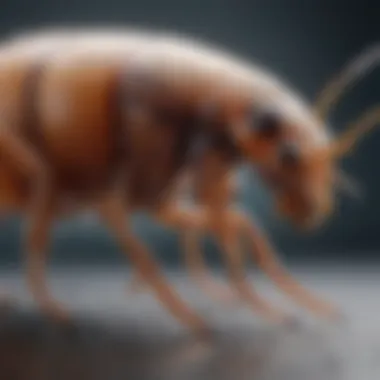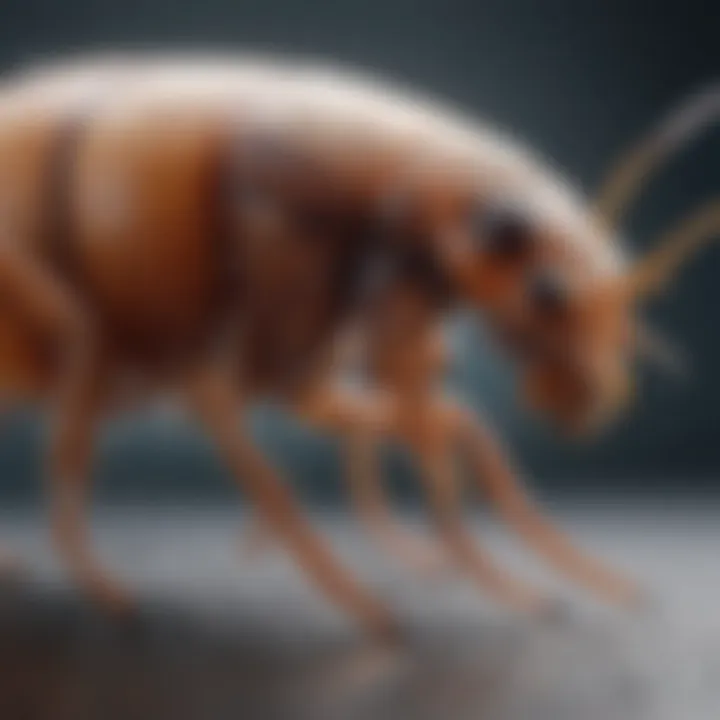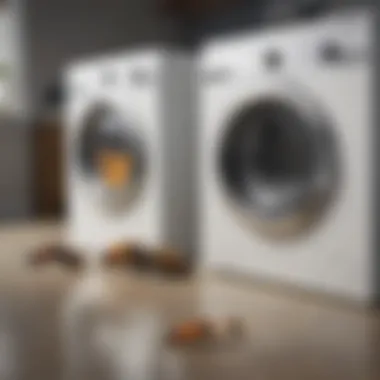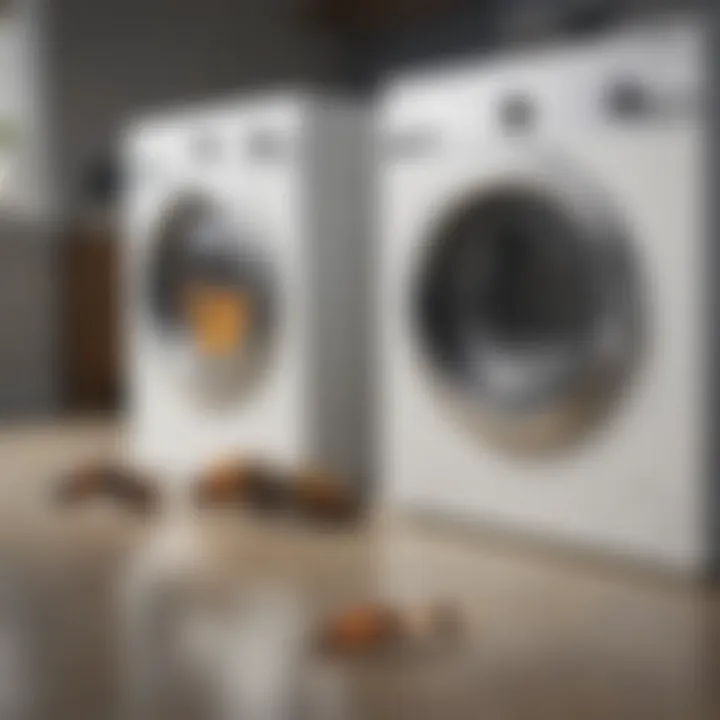Efficacy of Dryers in Eliminating Fleas


Intro
Fleas are a persistent problem for many households, causing discomfort for both pets and humans. Addressing infestations requires a thorough understanding of the pest, effective prevention strategies, and appropriate control methods. This article will evaluate the role of dryers in eradicating fleas from household fabrics. By dissecting the biology of fleas and discussing how heat can impact their lifecycle, homeowners can make informed decisions on pest management.
Understanding the Pest
Identification
Fleas are small, wingless insects known for their ability to jump considerable distances. Adult fleas are typically brown or black, measuring about 1/8 inch in length. Their presence often indicates a larger infestation, as they reproduce rapidly. Homeowners might notice fleas on pets or in the vicinity of infested areas, characterized by small, itchy bites on themselves or their animals.
Life Cycle
The flea life cycle includes four stages: egg, larva, pupa, and adult. Each stage presents unique challenges for eradication:
- Egg: Adult female fleas lay up to 50 eggs per day. These eggs usually fall off the host animal into bedding or carpets.
- Larva: The larvae feed on organic debris found in their environment, such as flea feces and shed skin.
- Pupa: In this stage, fleas enter a cocoon and can remain dormant for extended periods, waiting for suitable conditions.
- Adult: Once conditions are right, they emerge to find a host, continuing the reproduction cycle.
Understanding this life cycle is crucial for effective control. More supportive measures should be taken for complete eradication, rather than relying solely on one method.
Pest Prevention Strategies
Environment Modification
Proper environmental modifications can significantly reduce the chances of a flea infestation. Regular cleaning of the home is essential. This includes vacuuming carpets, upholstery, and pet bedding to remove eggs and larvae. It is also advisable to wash fabrics in hot water when necessary, as this can help eliminate any hidden pests.
Physical Barriers
Using physical barriers can be effective in limiting flea access to living areas. Installing screens on windows, as well as ensuring that cracks and crevices are sealed, can help keep these pests outside. Additionally, treat pets with regular vet-recommended flea treatments to avoid bringing fleas indoors.
Control Methods
Chemical Control
Chemical treatments are often considered when an infestation is established. Various commercial products are available, including flea sprays and powders. They often contain insect growth regulators and adulticides. Care should be taken to follow instructions on the label to ensure safety for both pets and humans.
Biological Control
Employing biological control methods can be an eco-friendly alternative. Introducing natural predators of fleas can help manage populations. Nematodes, for example, are microscopic roundworms that can feed on flea larvae, reducing their numbers effectively.
"Understanding the flea life cycle is a key element in successful and long-lasting pest management."
The Role of Dryers in Flea Eradication
Using a dryer can play a crucial role in the eradication of fleas from fabrics. High temperatures can effectively kill fleas at all life stages, but specific conditions must be met. It is vital to ensure that items are heated to a suitable temperature and held for an adequate duration. Although a dryer is not a standalone solution, it can be a valuable part of a comprehensive flea management strategy.
For thorough pest control, it is essential to combine environmental modifications, the use of physical barriers, and appropriate control methods. Always consider various options, including the use of heat through dryers, for an effective approach to maintaining a pest-free home.
Prelude
The issue of flea infestation in household fabrics is not only bothersome but also poses significant health concerns. Understanding the role that dryers play in the eradication of fleas is crucial for homeowners. Fleas can cause discomfort to both pets and humans. They thrive in warm, dark environments and often hide in fabrics like blankets, carpets, and pet bedding.
Dryers use heat, a method that has shown potential in controlling flea populations. The importance of this article lies in its focus on practical measures for flea control, particularly the use of a dryer as a possible solution. By analyzing the mechanics of heat against flea biology, the discussion aims to offer insights that empower homeowners to tackle this problem effectively.
This exploration includes the temperature thresholds needed to effectively kill fleas, the duration of drying cycles, and the potential limitations of relying on dryers alone. Understanding these factors is fundamental for crafting a comprehensive pest management plan.


Readers will benefit from this information, as it aids in making informed decisions about pest control. Ultimately, the aim is to provide a well-rounded perspective that includes not only the efficiency of dryers but also complementary pest control methods that enhance overall effectiveness in maintaining a flea-free environment.
Understanding Fleas
Fleas are more than just nuisances; they are persistent parasites that have adapted remarkably well to living in close quarters with humans and their pets. By understanding fleas, homeowners can make informed decisions regarding pest control measures, particularly the use of dryers in eradicating these pests from fabrics. Understanding their biology, life cycle, and behavior equips individuals with the knowledge necessary to combat infestations effectively.
Biology of Fleas
Fleas belong to the order Siphonaptera. They are small, wingless insects with a body designed for jumping long distances. This unique morphology allows them to move quickly from host to host. Adult fleas are approximately 1.5 to 3.3 millimeters in size and are characterized by their laterally compressed bodies, which assist in hiding within fur or fabrics.
Fleas possess a complete digestive system that requires blood for survival. They have specialized mouthparts adapted for piercing skin and sucking blood. Their saliva contains anticoagulants to prevent the blood from clotting and to facilitate feeding. In addition, fleas can detect their hosts through various stimuli, including heat, carbon dioxide, and pheromones.
Life Cycle of Fleas
Fleas undergo a complete metamorphosis, consisting of four life stages: egg, larva, pupa, and adult. This life cycle has implications for control methods, including heating methods such as dryer usage.
- Eggs: Adult female fleas lay approximately 20 to 30 eggs daily. These eggs are oval and white and fall off the host into the environment, often into pet bedding or carpets.
- Larvae: The eggs hatch within a week into larvae. Larvae are blind and prefer dark and humid environments. They feed on organic debris, including adult flea feces, which is comprised of undigested blood.
- Pupae: After two to three weeks, the larvae spin cocoons to enter the pupal stage. This stage may last for days or even months, depending on environmental conditions and host availability.
- Adults: Once conditions are favorable, adult fleas emerge from the pupae. The cycle can restart, leading to rapid population growth.
Understanding this life cycle is crucial because dryers primarily target adult fleas and some pupae. Ensuring that these insects are adequately exposed to heat during the drying process can diminish their presence in the home significantly.
Habitats and Behavior
Fleas thrive in various settings, particularly those that offer warmth and shelter. Common habitats include:
- Pet environments: Such as beds, carpets, and shared spaces with domestic animals.
- Outdoor areas: Lawns or gardens where pets often roam.
- Indoor areas: Cracks, crevices, and upholstered furniture.
Flea behavior is heavily influenced by their need for a host. Adult fleas exhibit territorial behavior, often preferring darker spaces that provide cover. Understanding their behaviors helps in developing effective strategies for extermination.
"Fleas are most active during warm and humid weather. Knowing their preferred environment can aid in limiting infestations."
Therefore, preventing seals, ensuring regular cleaning, and using heat can limit flea ingress into homes. Overall, a comprehensive understanding of fleas' biology, life cycle, and habitats informs more efficient pest management strategies.
Mechanics of Heat as Control Method
Understanding the mechanics of heat as a pest control method is crucial in addressing flea infestations effectively. When homeowners consider eradicating fleas, heat application emerges as a practical approach due to fleas’ vulnerability to temperature changes. This section will examine how heat impacts fleas, the temperature thresholds needed for effective eradication, and the overall benefits of using heat as a control mechanism.
A clear grasp of these mechanics will arm homeowners with the knowledge necessary to make informed decisions when combating these pests. Since fleas reproduce quickly and can spread rapidly, employing an effective strategy to break their life cycle is essential.
How Heat Affects Fleas
Heat influences fleas significantly. Fleas thrive in moderate temperatures, typically between 65 to 80 degrees Fahrenheit. When the temperature rises beyond this range, it negatively impacts their survival. High heat can disrupt their biological functions. The drastic temperature exposure can kill fleas in different life stages, including adult fleas, larvae, and eggs.
Research indicates that temperatures above 95 degrees Fahrenheit are lethal to adult fleas within a short exposure period. Larvae are also susceptible to higher temperatures. Heat causes dehydration in fleas, effectively immobilizing them and leading to death. Furthermore, exposing flea-infested fabrics to heat not only kills existing fleas but also interrupts the life cycle of emerging fleas.
"Effective pest control with heat relies on understanding flea biology and their reactions to temperature changes."
Through direct exposure to heat, homeowners can reduce flea populations significantly. Therefore, using a dryer can be an effective strategy when properly executed.
Temperature Thresholds for Fleas
Understanding the specific temperature thresholds necessary to eradicate fleas is vital. Generally, the following temperature ranges are important:
- 90°F to 95°F: Effective for causing stress in adult fleas. They will start seeking cooler environments but not necessarily die.
- 95°F to 125°F: Begins to affect larvae and eggs. Exposure in this range can cause significant adverse effects, leading to their death within a few hours.
- Above 125°F: This is the lethal temperature range for all flea life stages. Adult fleas, larvae, and eggs cannot survive prolonged exposure.


For practical application in dryers, maintaining a setting around 130°F to 140°F for at least thirty minutes is typically recommended. This duration is crucial as it ensures that heat penetrates fabric deeply enough to eliminate fleas hiding within the fibers. While each dryer may operate slightly differently, using respective heat settings effectively will enhance the chances of flea eradication.
In summary, understanding how heat affects fleas and knowing the optimal temperature thresholds required for extermination provide essential tools for homeowners. This knowledge lays the groundwork for using dryers effectively in controlling flea infestations.
Dryer Efficacy in Flea Elimination
Flea eradication from household fabrics is a crucial concern for many homeowners. As pests, fleas can cause health issues and significant discomfort. Thus, understanding the efficacy of dryers in this context holds considerable importance. Not only do dryers utilize heat to combat these pests, but they also offer a practical solution when combined with other methods. This section explores the specific elements and benefits of using dryers in flea elimination, as well as considerations homeowners should keep in mind.
Optimal Settings for Flea Control
For maximum effectiveness in eradicating fleas, the settings on the dryer are key. It is critical to use a high heat setting, as fleas are sensitive to temperature changes. Most experts suggest that a dryer temperature of at least 130°F (54°C) is required to kill adult fleas and disrupt their eggs. In addition to temperature, the drying time is also significant. Typically, running the dryer at high heat for a minimum of 30 minutes can enhance the likelihood of full eradication of fleas.
- Temperature: Ensure the dryer reaches and sustains an optimal temperature of at least 130°F.
- Setting: Select high heat or 'sanitize' settings, which are designed to eliminate pests.
- Fabric: Always check that the fabrics being dried can withstand high temperatures to avoid damage. Properly managing these settings can yield successful outcomes in flea control.
Duration of Drying Cycles
Duration plays a pivotal role in the process of flea eradication. The drying cycle must be long enough to expose fleas and their eggs to lethal temperatures. As mentioned, a general guideline is to run the dryer for no less than 30 minutes on high heat.
- Short Cycles: Brief drying durations may not provide sufficient exposure to heat, leading to ineffective flea control.
- Longer Cycles: Extending the drying time to around 40-50 minutes can optimize results, especially for heavier fabrics.
- Multiple Loads: For larger loads, consider running multiple cycles to ensure that every piece of fabric has adequate exposure to heat.
By understanding these dynamics, homeowners can better strategize their approach to using a dryer in the fight against fleas.
Limitations of Using a Dryer
Understanding the limitations of using a dryer in flea eradication is crucial for homeowners. This section will highlight important aspects, potential drawbacks, and the considerations involved when relying on this method alone.
Fabric Sensitivity to Heat
Not all fabrics can withstand high temperatures. Many household textiles are delicate and may suffer damage if exposed to heat during drying cycles. For instance, materials like silk or certain synthetic fabrics can result in shrinkage or loss of shape when subjected to the dryer’s high heat. It is essential to check the care labels of fabrics before subjecting them to heat treatments.
Homeowners should also consider the longevity of these fabrics. Frequent exposure to heat can accelerate wear and tear. Thus, while the dryer may help eliminate fleas, it might compromise the integrity of sensitive items. This creates a dilemma: the need to eliminate pests versus maintaining the quality of household items.
Potential for Flea Resistance
There is also concern regarding the potential for fleas to develop resistance to the heat method used in dryers. As home environments adjust to specific pest control strategies, fleas may adapt over time. This adaptability can lead to a situation where previously effective methods become less efficient. Heat exposure may kill a significant number of fleas, but some resilient individuals can survive.
Research indicates that resistance can emerge from a combination of factors, including temperature, exposure time, and the reproductive cycles of the fleas. If populations persist, they may breed and produce offspring that are similarly resistant. For homeowners, this presents a significant challenge: relying solely on dryers may not provide a permanent solution to flea infestations.
In summary: while dryers can aid in the eradication of fleas, they come with limitations such as fabric sensitivity and the potential development of resistance, making it necessary for homeowners to incorporate additional pest control strategies.
Complementary Pest Control Methods
To effectively eradicate fleas from household fabrics, it is essential to consider methods that complement the use of dryers. Relying solely on one method might not yield desired results. A multipronged approach can enhance the overall effectiveness of flea control. This section explores three primary methods: vacuuming, chemical treatments, and natural options. Each plays a important role in managing flea infestations.
Vacuuming as an Essential Tool
Vacuuming is a fundamental first step in flea control. It is effective in physically removing fleas, eggs, and larvae from carpets, upholstery, and other surfaces. A vacuum with strong suction can help capture fleas that may not be affected by heat alone.
Benefits of Vacuuming:
- Immediate Removal: Vacuuming quickly eliminates visible fleas and debris.
- Egg and Larvae Control: It prevents the cycle by removing eggs and younger fleas.
- Dirt Removal: It cleans up common breeding grounds, which may attract pests.
When vacuuming, focus on:


- Areas where pets frequent.
- High-traffic spots like living rooms or hallways.
- Under furniture and in corners.
Chemical Treatments
Chemical treatments can supplement the mechanical efforts of vacuuming and dryer use. Products specifically designed for flea eradication can be very effective in killing adult fleas and preventing larvae development.
Considerations for Chemical Treatments:
- Safety: Always read labels and ensure the products are safe for both pets and humans.
- Application: Follow instructions carefully to maximize effectiveness.
- Follow-Up: You may need to repeat treatments after a certain period to manage reinfestation.
Some common chemical treatments include:
- Flea sprays.
- Foggers or bombs.
- Spot-on treatments for pets.
Natural and Eco-Friendly Options
For those preferring greener alternatives, natural remedies can assist in flea control. While these may not always be as powerful as chemical options, they do have advantages.
Benefits of Natural Options:
- Pet-Safe: Many natural treatments are less harmful to pets and humans.
- Environmental Impact: They often have a lower ecological footprint.
Popular natural methods include:
- Diatomaceous Earth: A powder that dehydrates fleas when they come into contact with it.
- Essential Oils: Certain oils like lavender and cedar are known to repel fleas.
- Salt or Baking Soda: Sprinkling these substances on carpets can dessicate flea eggs.
Combining these methods, from vacuuming to natural options, can significantly boost the chances of effectively controlling flea populations in your home.
Precautions When Using a Dryer
Using a dryer can be an effective method in the fight against fleas. However, certain precautions must be considered to maximize its efficacy while minimizing potential risks. Pay attenton to fabric types and monitor the drying process closely. Understanding these precautionary measures can ensure the desired outcome without causing harm to clothing or upholstery.
Monitoring Fabric Condition
Before placing items in the dryer, check each fabric's care label. Not all materials can withstand high temperatures. For instance, delicate fabrics like silk or wool might shrink or become damaged. It is advisable to do a test run with a small piece of fabric first. Additionally, observe the condition of the items after each drying cycle. If any signs of wear or fading appear, discontinue further use in the dryer.
Regular checking helps maintain fabric integrity while addressing any flea-related issues. If you notice any changes, opt for alternative pest control methods, such as steam cleaning or professional services.
Avoiding Cross-Contamination
Cross-contamination can hinder flea eradication efforts. Ensure that items going into the dryer are free from live fleas and eggs. Before loading the dryer, vacuum the fabrics thoroughly. This helps remove fleas before they encounter the heat. Also, ensure to separate potentially infested items from clean ones.
Storing fabrics in designated bags can also help. This reduces the chance of flea migration from one surface to another. Always empty the lint trap after every session, as fleas can sometimes get trapped within the lint.
"Taking simple precautions while using a dryer can dramatically enhance the efficacy of flea control measures in fabrics."
By implementing these practices, individuals can maximize their efforts to eliminate fleas while protecting their household fabrics. The right precautions make a significant difference in effective pest management.
The End
The discussion surrounding the efficacy of dryers in eradicating fleas emphasizes significant points for both homeowners and pest management. Through understanding how heat operates against flea populations, readers gain a clearer perspective on practical pest control measures and their implementation in everyday life.
One of the core elements addressed is the effectiveness of dryer heat in targeting fleas at various life stages. This knowledge is crucial since it enables householders to make informed decisions. Using a dryer can significantly reduce flea populations, given the right settings and duration. This is particularly beneficial for fabrics that fleas commonly inhabit, such as bedding and clothing.
In addition, we must consider the limitations of this method. Acknowledging factors such as fabric sensitivity to high temperatures and the potential for flea resistance is essential. These nuances ensure that users do not solely rely on the dryer without incorporating other methods of pest management. Integrating complementary strategies enhances the overall effectiveness and addresses the multifaceted nature of flea control.
Ultimately, the conclusion highlights that while dryers serve as a viable option in the battle against fleas, they represent just one component of a broader approach. Homeowners should strive for a comprehensive pest control strategy that includes ongoing monitoring and potentially the use of vacuuming, chemical treatments, and natural solutions. This multifaceted approach not only increases efficiency in eradicating fleas but also promotes a healthier environment for all household members.
"A comprehensive stance against pests incorporates various methods, ensuring a more effective outcome."
By grasping the balance between using dryers effectively and understanding the limitations, homeowners are better equipped to maintain a pest-free setting. Adjusting perspectives on flea management can lead to improved outcomes, ensuring that home environments remain safe and comfortable.







